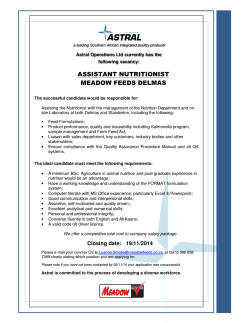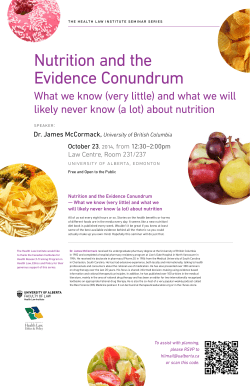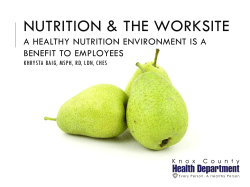
Brussels Development Briefing n. 41 Improving
Brussels Development Briefing n. 41 Improving nutrition through accountability, ownership and partnerships Organised by CTA, the ACP Secretariat, the European Commission, Concord in collaboration with the IFPRI-Led CGIAR Research Program on Agriculture for Nutrition and Health (A4NH) 20th May 2015, 9h00-13h00 ACP Secretariat, 451 Avenue Georges Henri, 1200 Brussels, room C http://brusselsbriefings.net 1. Context 1 Malnutrition and udernutrition : a burden for many ACP countries Malnutrition affects one in two people on the planet. Of these, 162 million children under the age of five are estimated to be stunted (i.e. low height for age). Two billion people are estimated to be deficient in one or more micronutrients. Nearly 1.5 billion people are estimated to be overweight and over 500 million to be obese. These conditions all have severe consequences for survival, for morbidity, and for the ability of individuals, the economy and society to thrive. In relation to the scale that these problems imply, the allocation of public resources to their prevention and amelioration is minuscule. Resources to specific nutrition programmes amount to a small fraction of one per cent of domestic or aid budgets. Undernutrition in early life can have devastating and life-long consequences for physical growth as well as cognitive and social development. Undernutrition remains one of the major challenges in low-income countries. The consequences of undernutrition in early childhood are especially devastating and can lead to lifelong physical and mental impairments. In May 2012, health leaders worldwide adopted the Maternal, Infant and Young Child Nutrition Plan at the 65th World Health Assembly (WHA). This includes committing to reduce the number of stunted children in the world by 40 per cent by 2025. Under existing assumptions, projections from the World Health Organization (WHO) and UNICEF show that the world is not on track to meet any of the six WHA nutrition targets. Globally, little progress is being made in decreasing rates for anemia, low birth weight, wasting in children under age five, and overweight in children under age five. Progress in increasing exclusive breastfeeding rates has been similarly lackluster. More progress has been made in reducing stunting rates in children 2 under five, but not enough to meet the global target under current projections. Malnutrition is either directly or indirectly responsible for approximately half of all deaths 3 worldwide. Poor nutrition and calorie deficiencies cause nearly one in three people to die prematurely or have disabilities (WHO). Each year about 10.9 million children younger than age five in developing countries die, and 60 percent of these deaths result from malnutrition and hunger-related diseases (WFP 2010). Moreover, millions of people suffer from serious vitamin and mineral deficiencies. Hunger and malnutrition have effects that last throughout the life cycle, with poorly nourished children growing up to be less healthy and productive than they could be. Girls who do not get the nutrition they need become undernourished women who then give birth to the next generation of undernourished children. 1 Malnutrition: an abnormal physiological condition caused by deficiencies, excesses or imbalances in energy, protein and/or other nutrients. Undernutrition: when the body contains lower than normal amounts of one or more nutrients, i.e. deficiencies in macronutrients and/or micronutrients. 2 International Food Policy Research Institute. 2014. Global Nutrition Report 2014: Actions and Accountability to Accelerate the World’s Progress on Nutrition. Washington, DC. 3 World Heath Organisation, A Review of Nutrition Policies, December 2010 http://www.who.int/nutrition/EB128_18_Backgroundpaper1_A_review_of_nutritionpolicies.pdf 1 While hunger is a major problem in sub-Saharan Africa, the excess intake of calories seriously undermines health in the Caribbean and Pacific regions. Chronic non-communicable diseases, many related to poor nutrition, now account for 57% of deaths in the Caribbean. A similar story can be told for the Pacific region, where half of the adult population is overweight. Malnutrition, in its various guises, deprives people of strength and energy, reducing their ability to work effectively. It is thus a significant cause of poverty and acts as a brake on socio-economic development. Diets centered on cheap, calorie-dense, nutrient-poor foods (including both “fast foods” and nutrient-poor staples) are deepening the emerging epidemic of obesity and chronic diseases in countries undergoing economic and nutrition transitions. Overweight affects more than 1 billion people globally, and obesity affects at least 300 million. The world is experiencing an overweight and obesity pandemic. At the same time the burden of disease in low- and middleincome countries is shifting rapidly from communicable to noncommunicable diseases. Micronutrient deficiencies remain a concern; anemia rates, for example, have not changed appreciably for more than 20 years and neither have wasting rates (WHO 2014a). Despite some improvement tracking financial resources to nutrition remains a challenge in terms of technology, data collection, coordination and planning. Increasing domestic resources to nutrition represents the only sustainable way of improving nutrition status. Estimates of undernourishment based on food supply are decreasing, but—with 805 million people below a minimum calorie threshold in 2012–2014—they are still high. Access to improved water and sanitation services is steadily improving, although large coverage gaps remain in Eastern, Western, and Middle Africa for water and in Southern and South-Eastern Asia and most regions of Africa for sanitation. Trends in female secondary education enrollment are positive for all regions, although the rate is still just 50 percent for Africa. Health services, though, are still lacking in Africa and Asia. Social protection spending is increasing rapidly in many African and Asian countries, providing a major opportunity to scale up nutrition-sensitive actions. The report offers some ideas for agriculture; social protection; education; health; and water, sanitation, and hygiene. Addressing nutrition challenges requires effective action and alliances across a number of sectors and areas (food, health, social welfare, education, water, sanitation, and women) and across a number of actors (government, civil society, business, research, and international development partners). 2. Nutrition is central to attaining Sustainable Development Goals Despite nutrition being one of the essential pillars of human development, global progress has been slow—with approximately 3.5 billion people malnourished or suffering from some form of micronutrient deficiency. Indeed, the prevalence of malnutrition in both developing and developed countries has gained widespread attention, as obesity exists side by side with undernutrition in almost every country. 4 However the Global Nutrition Report 2014 assessment of the Global Nutrition Targets for 2025 set by the World Health Assembly (WHA) shows that the world is not on track to meet any of these goals. The responsibility of addressing malnutrition does not rest solely with governments, but requires a multidimensional approach where civil society holds governments to account in their commitments and the private sector supports scaling up through innovative interventions. 4 The report was originally called for by the signatories of the Nutrition for Growth (N4G) Summit Compact in 2013 in recognition of the need to better monitor commitments to improving nutrition. The Report was delivered by an Independent Expert Group and guided at a strategic level by a Stakeholder Group, whose members also reviewed the Report. The International Food Policy Research Institute (IFPRI) oversaw the production and dissemination of the Report, with the support of the Secretariat based at the Institute of Development Studies (IDS). The Lancet, the premier peer-reviewed medical journal, managed the blind external review process for the Report, which was launched during the Second International Conference on Nutrition (ICN2) in Rome in November 2014. There will be follow-up events for the Report in a several cities around the world. http://globalnutritionreport.org/the-report/ 2 National evaluation platforms and community feedback mechanisms are promising ways of strengthening nutrition accountability, but they need to be piloted and evaluated. National and international nutrition research programs that are driven by the problems of countries themselves are likely to improve accountability at the national level. To improve accountability, funders should invest in increasing staffing capacity in national CSOs and finance the process of collecting and collating information on Non-communicable diseases (NCD) policy implementation and indicators of good nutrition governance. Of particular concern is nutrition’s low profile in the current SDG framing. There are a total 169 draft targets: 109 on what to achieve and 60 on how to achieve them. Only 1 of 109 draft “what” targets is directly related to malnutrition: Target 2.2 by 2030 end all forms of malnutrition, including achieving by 2025 the internationally agreed targets on stunting and wasting in children under five years of age, and address the nutritional needs of adolescent girls, pregnant and lactating women, and older persons (Open Working Group on Sustainable Development Goals 2014) None of the 60 “how” targets relate directly to nutrition. The broad nature of target 2.2 suggests that the nutrition community must become more engaged in the post-2015 process to position nutrition thoughtfully and strategically in the post-2015 development accountability framework. At a minimum, government and civil society nutrition champions should work together to embed not only targets related to stunting and wasting, but all six internationally agreed WHA targets within the 169 targets. Encouragingly, more than two-thirds of all countries that have data on all four indicators will meet at least one goal. African countries represent about 50 percent of the countries in the groups on course to meet zero, one, and two targets. Asian countries represent 42 percent of countries on course to meet 0 targets and about 25 percent of countries on course to meet one or two targets. 3. Linking agriculture, nutrition and health: a necessity Agriculture plays a central role in improving food availability and quality, increasing incomes, supporting livelihoods and contributing to the overall economy and is thus a key factor in efforts to improve food and nutrition security. Development of the agricultural sector is especially crucial to alleviating poverty in developing countries, where a large proportion of gross domestic product is generated within the primary sector by smallholders. Promoting and improving food-based systems not only ensures sustainable food and nutrition security, but improves diets combating micronutrient deficiencies. However, given the complex nature and the different causes of this phenomenon, interventions targeting the agricultural sector cannot alone tackle efficiently this problem. Ways in which agriculture can sustainably contribute to improving dietary diversity and nutrition outcomes include support for agricultural extension services that offer communities information and improved inputs; integrated agro-forestry systems that reduce deforestation and promote harvesting of nutrient-rich forest products; aquaculture and small livestock ventures that include indigenous as well as farmed species; education and social marketing strategies that strengthen local food systems and promote cultivation and consumption of local micronutrient rich foods; biofortification via research and development programmes that breed plants and livestock selectively to enhance nutritional quality; and reduction of postharvest losses via improved handling, preservation, storage, preparation and processing 5 techniques. Growth strategies should be designed with a nutritional lens and take into account what type 5 The Sixth Report on the World Nutrition Situation. http://www.unscn.org/files/Publications/RWNS6/report/SCN_report.pdf 3 of sector and subsectoral practices and policies can enhance nutrition. Agriculture growth strategies, for example, could contribute to increasing demand for and access to nutritious foods along the entire value chain. Value-chain approaches are already used in international development with the objective of enhancing the livelihoods of food producers but they rarely 6 consider diet quality and nutrition. Nutrition-sensitive value chains can be built through various interventions, including consumer knowledge and awareness campaigns that increase demand for nutrient-rich foods and new 7 tools that improve the nutritional value of foods along the value chain. Poor farmers will benefit if placed in a position where they can appropriate a greater amount of the returns accruing from the chain, particularly in light in the differentiation strategies pursued by global agribusiness (KIT 2010). Recent work has begun to identify how such value-chain approaches could be improved with regard to their consideration of gender, the environment, and some of the nonincome dimensions of poverty (e.g.,lack of access to public services). For example, with the aim of supporting value-chain approaches that work better for women, Gammage (2009) developed a gender-sensitive form of value chain analysis that identifies how many men and women are involved in the different activities in the chain and how the 8 different marketing activities are targeted to different genders. An important technological solution involves the breeding of micronutrient-rich staple food crops with high concentrations of important vitamins. Biofortification, as it is known, requires considerable upfront investment, but may prove more cost-effective than providing supplements to vulnerable groups. There have already been notable successes with the orange-fleshed sweet potato, rich in vitamin A, in Uganda and Mozambique. 4. Progress in improving nutrition outcomes: more investments needed in data at national level Countries cannot currently track their financial commitments to nutrition and organizational capacity needs to be strengthened. Effective nutrition monitoring systems are crucial for governments and other agencies to capture undernutrition in its early stages, track trends and inform rapid decision-making. Credible and timely data is also important to hold stakeholders accountable for their commitment to deliver nutrition services and combat undernutrition. Disaggregated analyses of nutrition outcomes are key. The benefit-cost ratios from investing in nutrition are highly competitive with investments in roads, irrigation, and health e.g. Gross domestic product (GDP) totals in Africa and Asia are less than 90 percent of what they would be in the absence of under-nutrition and in China, approximately 95 percent of what they would be in the absence of obesity. These gaps included data on countries’ capacity to implement and scale up nutrition actions, program costs, and financial resource tracking. Many decisions about how to prioritize the filling of data gaps need to be undertaken at the national level, based on nutrition policies, plans, and strategies. The systematic and periodic collection of information on nutrition is vital to the capacity of governments and other agencies to track their progress towards reducing undernutrition, to promoting the accountability of their actions and to improving their ability to respond promptly to rapid changes in nutrition status brought about by food price volatility and other shocks. However, nutrition surveillance is expensive (a national nutrition survey typically costs about US$1 million) and logistically laborious and therefore often non-existent in resource-low countries. Surveillance systems are also constrained by time-consuming and error-prone paper-based data collection followed by manual data entry. Data transfer may take months to 6 Hawkes, Corinna and Marie Ruel. 2011. Value Chains for Nutrition. 2020 Conference Paper 4. Washington, D.C.: International Food Policy Research Institute (IFPRI). 7 Ibid 8 Ibid 4 reach a level at which they can be analysed and lack of human resources to accomplish analysis often leads to further delays and often underuse of surveillance data. Consequently, monitoring of nutrition outcomes in real time and timely response to nutritional crises is often 9 impossible. Only 99 out of 193 countries have sufficient data to assess whether they are on or off course for four WHA indicators. Many of the indicators are based on surveys that are more than five years old. Nearly 50 per cent of all countries cannot track all four health status indicators and only 40 per cent of countries measure the height and weight of young children over five years old. There is need for improved data collection and accountability on how targets should be set and how to assess impacts and results. In recent years, there has been increasing enthusiasm for the potential of Information and Communications Technology (ICTs) to enable quicker and better data collection, transfer and analysis, which can inform decision-making in a timely manner. Mobile phone technologies can also allow communities and civil societies to monitor commitments to undernutrition 10 reduction. IDS review identified some evidence that ICTs may make tracking and monitoring of nutrition quicker and more efficient, for example, by speeding up data transfer and reducing data entry errors. Nevertheless, there is still little sense of how nutrition monitoring data can be used most effectively and what role ICTs may play in this. Data gaps hold back action but this does not necessarily require collecting new data: existing data can be used more effectively, quality of existing data collection can be strengthened, cross-country data comparability can be improved, increased frequency in national surveys. Collecting new data is necessary where more accountability is needed. Many of these data gaps can be filled by investing in the capacity of nutrition analysts, program managers, and policy units to make better use of existing data. 5. Developing and Sustaining Innovative Partnerships for nutrition Between 2010 and 2012, commitments from 13 donors to nutrition- specific interventions rose by 39 percent, and disbursements rose by 30 percent. Nutrition-sensitive donor commitments declined by 14 percent, but nutrition-sensitive disbursements for the 10 donors that reported data increased by 19 percent. The percentage of official development assistance disbursed to nutrition in 2012 was just above 1 percent. Donor reporting on nutrition is becoming more 11 harmonized but has further to go owing to differences in definitions and timing. The 2013 EU policy on nutrition outlines a strategic framework to tackle undernutrition from both the development and humanitarian perspective. Three strategic priorities are outlined: - The EU aims at a stronger mobilisation and political commitment for nutrition at country and international level (inter alia through the Scaling Up Nutrition (SUN) movement). - In order to enable a sustainable change for people suffering from undernutrition, nutrition interventions will be stepped up at country level. - The EU will invest in applied research and support information systems. It will also provide technical expertise for the implementation of support The EU is the largest contributor to the SUN movement, which is founded on the principle that all people have a right to food and good nutrition. SUN has been successful in building broad global alliances to move nutrition higher up the international development agenda and ensure stronger political commitment to reducing stunting. It involves a wide variety of partners, including governments, civil society and the United Nations as well as donors, 9 Inka Barnett and Jose V. Gallegos. Using mobile phones for nutrition surveillance: a review of evidence. Institute of Development Studies in March 2013 http://opendocs.ids.ac.uk/opendocs/bitstream/handle/123456789/2602/AGER1.pdf?sequence=1&utm_source=idswe bsite&utm_medium=download&utm_campaign=opendocs 10 Ibid 11 International Food Policy Research Institute. 2014. Global Nutrition Report 2014: Actions and Accountability to Accelerate the World’s Progress on Nutrition. Washington, DC. 5 businesses and researchers. These partners intend to reduce the number of children under five affected by stunting by at least 7 million as a contribution towards the World Health Assembly’s goal for 2025. In order to help transform these political commitments into actions and investments, the EU has pledged to commit considerable energy and resources. It is mobilising €3.5 billion between 2014 and 2020. The EU has adopted an Action Plan on Nutrition that describes the actions leading to the attainment of this goal. In line with its policy framework, the EU is also working to develop an accountability framework to monitor commitments and impact and has taken the lead, in close collaboration with other key partners, in developing the appropriate tools for this purpose. 12 The Scaling Up Nutrition (SUN) Movement , initiated in 2010, has more than 50 country or state-level members and has been instrumental in stimulating and sustaining commitment to nutrition. Progress in improving micronutrient deficiencies is slow but has received renewed global attention (such as in the 2014 Global Hunger Index). The signatories to the N4G Compact in London in 2013 pledged more than US$4 billion in extra financing for undernutrition reduction until 2020. The second International Conference on Nutrition in Rome and the follow-up high-level nutrition event planned for the 2016 Rio de Janeiro Summer Olympics will be key steps forward. Beyond international commitments, at the ACP regional level, several major efforts to improve nutrition are underway. The African Regional Nutrition Strategy 2005-2015 (ARNS) was adopted by the Conference of African Ministers of Health, held in Gaborone, Botswana, in October 2005. It was subsequently adopted by the Summit of the Heads of States of the African Union (AU) in January 2006 in Sudan (AU 2006). The strategy recognised that there is a disconnect between efforts to boost nutrition and efforts to improve national socio-economic development. This has led to low investment in nutrition at international, regional, national and sub-national levels. The Pan-African Nutrition Initiative (PANI) was developed under the umbrella of the New Partnership for African Development (NEPAD), a programme of the African Union. CAADP Pillar 3 aims to increase food supply, address nutritional security and improve responses to food emergencies across the region by raising smallholder productivity and improving responses to food emergencies. Pacific populations are at great risk of malnutrition, food-borne diseases and noncommunicable diseases (NCDs). More than 50% of adults are overweight in most Pacific countries, and in some of these countries, over 40% of the population suffers from diabetes. In the Caribbean, the Special Meeting of the Council for Trade and Economic Development (COTED) Agriculture, held in Grenada in October 2010, endorsed the ‗Regional Food and Nutrition Security Policy and Action Plan‘. This provides a comprehensive framework to ensure that the region has an adequate, stable and nutritious supply of food 6. The way forward Bringing agriculture to bear on improving nutrition and health will require government leadership at all levels — from national to local. Policy-makers need to understand the complexity of factors contributing to fight malnutrition and commit to ensure food for all and safe food for all. Professionals from agriculture, nutrition, and health sectors need to engage together and to explain to a wider public the interactions and interdependency amongst those areas. Civil society, farmers and consumers groups need to strengthen their advocacy efforts 13 while the donor community can support capacity building at all levels. 12 Scaling Up Nutrition (www.scalingupnutrition.org) is a global movement led by 54 member countries. These member countries, which seek to prioritize efforts to address malnutrition, are supported by a wide range of development partners from civil society to the UN, donors, research institutes, and businesses. One of the premises of SUN is that efforts to reduce malnutrition need to become more coordinated across sectors and stakeholders and more aligned with results frameworks. 13 IFPRI /CTA. Addressing ACP nutrition security: the key role of agriculture. Rajul PandyaLorch, Isolina Boto, 2011. http://tinyurl.com/3uw623p 6 A strong commitment to improving nutrition faster and build this goal into the post-2015 process is needed. Better data on nutrition outcomes and nutrition financing, as well as increased investments in nutrition-sensitive programs and the development of effective accountability mechanisms, will be crucial elements in scaling up nutrition action. There is an urgency in compelling evidence that improved nutritional status should be an explicit objective of agricultural interventions. Nutrition goals should be overtly incorporated into agricultural projects and policies to achieve a positive impact on nutrition. Nutrition education should also be integrated into agricultural programmes. In this context, women‘s role as food producers and primary caregivers for their children should be recognised and strengthened while their access to productive resources should be promoted. Nutrition resources and expertise needs to be better aligned toward the evolving nature of malnutrition. Effective monitoring and accountability systems are crucial and more investment would be needed in the use of ICTs for nutrition monitoring as well as tracking of financial commitments to nutrition. Furthermore, more research on implementation is needed to show how to improve the effectiveness of existing proven interventions. Objectives of the Briefing To improve information sharing and promote networking, CTA, the DG DEVCO from the European Commission, the ACP Secretariat, Concord and various media organise bimonthly briefings on key issues and challenges for rural development in the context of EU/ACP th cooperation. The Briefing on 20 May 2015, organised with IFPRI-Led CGIAR Research Program on Agriculture for Nutrition and Health (A4NH), will discuss the key challenges and new opportunities to strengthen linkages between agriculture and nutrition in ACP countries The Briefing will: i) share the latest evidence on progress in improving nutrition in ACP countries; ii) promote the exchange of information on best practices and sustainable partnerships; iii) feed into the debate various perspectives on policy options. Target group More than 150 ACP-EU policy-makers and representatives of EU Member States, civil society groups, research networks and development practitioners, and international organisations based in Brussels. Available material Input and comments before, during and after the meetings will be included in the Briefings blog: http://brusselsbriefings.net/. A short report and a Reader in printed and electronic format will be produced shortly after the meeting. 7 Brussels Development Briefing n. 41 Improving nutrition through accountability, ownership and partnerships Organised by CTA, the ACP Secretariat, the European Commission, Concord in collaboration with the IFPRI-Led CGIAR Research Program on Agriculture for Nutrition and Health (A4NH) 20th May 2015, 9h00-13h00 ACP Secretariat, 451 Avenue Georges Henri, 1200 Brussels, room C http://brusselsbriefings.net Programme 8h00-9h00 Registration and Welcome Coffee 9h00-9h15 Introduction of the Briefing Introductory remarks: Dr. Patrick Ignatius Gomes, Secretary-General of the African, Caribbean and Pacific Group of States (ACP; Klaus Rudischauser, Deputy Director-General Policy and Thematic Coordination, European Commission/Europaid; John McDermott, Director IFPRI-Led CGIAR Research Program on Agriculture for Nutrition and Health (A4NH); Michael Hailu, Director, CTA 9h15-11h00 Panel 1: Enhancing nutrition: a multi-sectoral approach This panel will review the key challenges and opportunities for enhanced nutrition of relevance to the agricultural sector in ACP countries and the lessons learned from research and practice. Panelists: - Overview of undernutrition & malnutrition: what do we know, what have we learned? Marie Ruel, Director, Division Poverty, Health and Nutrition, IFPRI - Key findings of the global nutrition report: improved accountability and ownership Lawrence Haddad, Senior Researcher, IFPRI - Initiatives at international level: The Scaling Up Nutrition (SUN) Tom Arnold, Interim SUN Movement Coordinator a.i., Ireland - Support partner countries in attaining their nutrition goals: the National Information Platforms for Nutrition Initiative Jean-Pierre Halkin, Head of Unit, Rural Development, Food & Nutrition Security, EC - CAADP perspective: linkages with national cases and investment NEPAD/CAADP 11h00-11h15 Coffee break 11h15-13h00 Panel 2: Best practices in addressing nutrition challenges This panel will look at examples and drivers of successes in nutrition programmes at national level. It will also highlight successes in sustainable partnerships and PPPs and the key role of the private sector. Panelists: - Successes in country leadership and ownership in addressing nutrition challenges Robinah Mulenga Kwofie, Executive Director, National Food and Nutrition Commission, Zambia The role of CSOs in support of nutrition: field experience Concord Successes in PPPs and the role of the private sector in support of nutrition Stephan Tanda, Managing Board Member, Royal DSM Drivers of success in biortification: the case of Iron-biofortified beans in Rwanda Lister Katsvair, Country Manager, HarvestPlus,Rwanda Conclusion Networking Lunch 8
© Copyright 2025









